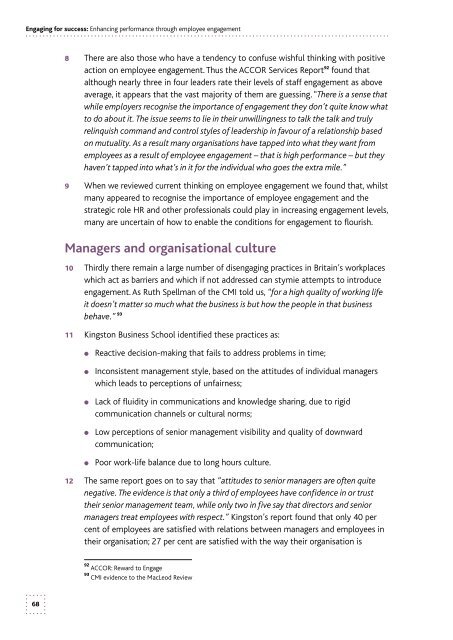3ytgeaf
3ytgeaf
3ytgeaf
Create successful ePaper yourself
Turn your PDF publications into a flip-book with our unique Google optimized e-Paper software.
Engaging for success: Enhancing performance through employee engagement<br />
8 There are also those who have a tendency to confuse wishful thinking with positive<br />
action on employee engagement. Thus the ACCOR Services Report 92 found that<br />
although nearly three in four leaders rate their levels of staff engagement as above<br />
average, it appears that the vast majority of them are guessing. “There is a sense that<br />
while employers recognise the importance of engagement they don’t quite know what<br />
to do about it. The issue seems to lie in their unwillingness to talk the talk and truly<br />
relinquish command and control styles of leadership in favour of a relationship based<br />
on mutuality. As a result many organisations have tapped into what they want from<br />
employees as a result of employee engagement – that is high performance – but they<br />
haven’t tapped into what’s in it for the individual who goes the extra mile.”<br />
9 When we reviewed current thinking on employee engagement we found that, whilst<br />
many appeared to recognise the importance of employee engagement and the<br />
strategic role HR and other professionals could play in increasing engagement levels,<br />
many are uncertain of how to enable the conditions for engagement to flourish.<br />
Managers and organisational culture<br />
10 Thirdly there remain a large number of disengaging practices in Britain’s workplaces<br />
which act as barriers and which if not addressed can stymie attempts to introduce<br />
engagement. As Ruth Spellman of the CMI told us, “for a high quality of working life<br />
it doesn’t matter so much what the business is but how the people in that business<br />
behave.” 93<br />
11 Kingston Business School identified these practices as:<br />
●● Reactive decision-making that fails to address problems in time;<br />
●● Inconsistent management style, based on the attitudes of individual managers<br />
which leads to perceptions of unfairness;<br />
●● Lack of fluidity in communications and knowledge sharing, due to rigid<br />
communication channels or cultural norms;<br />
●● Low perceptions of senior management visibility and quality of downward<br />
communication;<br />
●● Poor work-life balance due to long hours culture.<br />
12 The same report goes on to say that “attitudes to senior managers are often quite<br />
negative. The evidence is that only a third of employees have confidence in or trust<br />
their senior management team, while only two in five say that directors and senior<br />
managers treat employees with respect.” Kingston’s report found that only 40 per<br />
cent of employees are satisfied with relations between managers and employees in<br />
their organisation; 27 per cent are satisfied with the way their organisation is<br />
92<br />
ACCOR: Reward to Engage<br />
93<br />
CMI evidence to the MacLeod Review<br />
68


